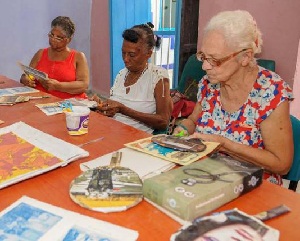 Cuba’s aging population – with 19.8% of the population aged 60 and over today – poses a series of challenges. In the social sphere, be it at the individual, family, or societal levels, not all are prepared to understand this phenomenon, as there are not adequate material resources or support networks to meet the demands that this stage of life requires.
Cuba’s aging population – with 19.8% of the population aged 60 and over today – poses a series of challenges. In the social sphere, be it at the individual, family, or societal levels, not all are prepared to understand this phenomenon, as there are not adequate material resources or support networks to meet the demands that this stage of life requires.
“Studies on aging in the world reveal a very important risk factor in these age groups, and our country is not exempt from this scourge, associated with violence. We refer to abuse and its manifestations,” Minsú Sotomayor Álvarez, MSc. in Public Health and Aging, and researcher at the Cuba’s Center for Research on Longevity, Aging and Health (CITED), told Granma.
She considers abuse to be any action, intentional or not, that produces harm from the biological, psychological, social, financial, or material point of few, as well as negligent behavior, be it temporary or permanent. “It occurs within any relationship where there is an expectation of trust and the most usual forms in which it occurs are physical, psychological, economic abuse or negligence, or neglect.
It is a little recognized problem by health teams, even when it is presented daily in geriatric consultations. It must be identified for timely intervention, since there are comprehensive solutions,” the researcher explained.
Regarding this phenomenon in adults and older adults in Cuba, Sotomayor commented on a recent study she conducted on patients admitted to CITED hospital wards, which had as its theme the abuse of dependent elderly people.
The results, she stressed, identified as forms of abuse negligence, psychological abuse and, to a lesser extent, financial abuse. No other forms were found in the sample, she added, referring specifically to physical abuse. Although this doesn’t mean that physical abuse does not occur, the study revealed that it is not the most common form of abuse among Cuba’s population.
However, there is a lack of knowledge on the part of caregivers of dependent patients about abuse of the elderly, and also of support networks. “Women aged 80 and over were the most mistreated; and as the degree of dependence increased, the abuse increased: negligence and psychological abuse,” the study showed.
In addition, regardless of the degree of harmony or discord in family relationships, this phenomenon was present, and caregivers were found to carry heavy burdens, the specialist noted.
CHARACTERIZATION OF VIOLENCE
Among the manifestations of violence and abuse discovered, the researcher mentioned threats of punishment or of taking the individual to an institution against his or her will; ignoring or unjustifiably confining him or her to a bed or chair, social isolation, refusing to respond to their concerns, using the world “old” to refer to them in a derogatory way, infantilizing them, overprotecting or depersonalizing them.
Likewise, the older adults surveyed reported other elements such as not being offered a seat on the bus, or help crossing the street; being excluded, disregard for their tastes in television programs, the improper use of their pension, forcing them to sign documents without their consent, be it due to their being mentally incapacitated to do so, or deception.
Providing suboptimal care at home, weight loss, be it unintentional or due to health conditions, dehydration, lack of hygiene; poor vision or hearing without correction, the aggravation of chronic diseases due to the withdrawal of necessary medications without prior consultation, causing physical pain; careless, dirty clothing, inappropriate for the time of year; the lack or poor state of prostheses (walkers, glasses, hearing aids, dentures, etc.); the search for or permanent change of professionals and/or health care centers; and unusual injuries to different parts of the body, were among the other manifestations identified.
The burden of caregivers and unawareness on how to manage stress could be, in the opinion of the specialist, one of the main triggers of situations of violence.
“To achieve an appropriate dynamic with the dependent older adult, it is valid to take advantage, whenever possible, of their integration with the environment that surrounds them in the neighborhood, acquaintances, friends and visiting places that provide entertainment,” Sotomayor stressed.
Allowing older adults to participate in activities with the rest of the family, whenever appropriate, encouraging walks and other physical activities which help them relate to other people, is essential, she added.
“It must be remembered that many times the person is ill, and this sometimes does not allow an adequate understanding of the task. The important thing is to get them out of the house and not take them to dangerous places where there is a lot of noise or a large number of people. It is opportune to participate in groups of people who have patients with the same conditions, this will allow them to inform themselves, relax, and make joint decisions,” she advised.
Sotomayor also recommended that caregivers contact community social services to assess whether they can receive support.
The aim is to promote a different view of older people, recognizing them as part of the society we enjoy today. Recognizing and identifying cases of violence or abuse is the first step. Dignity, in the end, does not age.
A WARNING
According to the World Health Organization, older people who see themselves as a burden to others can end up thinking that their life has less value and, as a consequence, they are more prone to depression and social isolation. In a recent study, it was observed that the average life expectancy of the older people surveyed who had negative attitudes regarding aging was 7.5 years shorter than that of those who had positive attitudes.
(Granma)